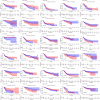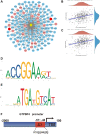Pan-cancer analysis revealed the significance of the GTPBP family in cancer
- PMID: 35320117
- PMCID: PMC9004551
- DOI: 10.18632/aging.203952
Pan-cancer analysis revealed the significance of the GTPBP family in cancer
Abstract
Background: At present, cancer is still one of the principal diseases to represent a serious danger to human health. Although research on the pathogenesis and treatment of cancer is progressing rapidly, the current knowledge on this topic is far from sufficient. Some tumors with poor prognoses lack effective prognostic biomarkers.
Methods: Firstly, the Wilcoxon test was used to analyse the expression of GTPBP1-GTPBP10 in cancerous and normal tissues. Subsequently, we explored the expression of GTPBP1-10 in cancer by way of a paired t-test and plotted the survival curve using KM and univariate Cox regression analysis to explore the relationship between GTPBP1-10 and the prognosis of cancer. We then explored the significance of the GTPBP family in the tumor microenvironment.
Results: The results showed that many members of the GTPBP family are differentially expressed in a variety of cancers and alter the prognosis of a number of cancers. Members of the GTPBP family may serve as novel prognostic markers for these tumors. Moreover, members of the GTPBP family are correlated with the immune microenvironment of tumors, which is valuable in terms of adding to our understanding of the mechanisms of tumor genesis. Finally, we identified drugs showing a high correlation with GTPBP family members, which are therefore conducive to the development of GTPBP family member-based treatment regimens.
Conclusions: The 10 members of the GTPBP family have prognostic value in multiple tumor types and are associated with the immune microenvironment. Our study may provide a reference for the diagnosis and treatment of tumors.
Keywords: GTPBP; biomarker; cancer; immunotherapy; pan-cancer analysis.
Conflict of interest statement
Figures










Similar articles
-
Systematic pan-cancer landscape identifies CARM1 as a potential prognostic and immunological biomarker.BMC Genom Data. 2022 Jan 16;23(1):7. doi: 10.1186/s12863-021-01022-w. BMC Genom Data. 2022. PMID: 35033016 Free PMC article.
-
Integrative data mining and meta-analysis to investigate the prognostic role of microRNA-200 family in various human malignant neoplasms: A consideration on heterogeneity.Gene. 2019 Oct 20;716:144025. doi: 10.1016/j.gene.2019.144025. Epub 2019 Aug 5. Gene. 2019. PMID: 31394177 Review.
-
A pan-cancer analysis of the HER family gene and their association with prognosis, tumor microenvironment, and therapeutic targets.Life Sci. 2021 May 15;273:119307. doi: 10.1016/j.lfs.2021.119307. Epub 2021 Mar 8. Life Sci. 2021. PMID: 33691171
-
A Pan-Cancer Analysis of the BIRC Gene Family and Its Association with Prognosis, Tumor Microenvironment, and Therapeutic Targets.Crit Rev Eukaryot Gene Expr. 2021;31(4):35-48. doi: 10.1615/CritRevEukaryotGeneExpr.2021038714. Crit Rev Eukaryot Gene Expr. 2021. PMID: 34587434
-
Assessment of RACGAP1 as a Prognostic and Immunological Biomarker in Multiple Human Tumors: A Multiomics Analysis.Int J Mol Sci. 2022 Nov 15;23(22):14102. doi: 10.3390/ijms232214102. Int J Mol Sci. 2022. PMID: 36430577 Free PMC article. Review.
Cited by
-
Application and research progress of cordycepin in the treatment of tumours (Review).Mol Med Rep. 2024 Sep;30(3):161. doi: 10.3892/mmr.2024.13285. Epub 2024 Jul 12. Mol Med Rep. 2024. PMID: 38994776 Free PMC article. Review.
-
A pan-cancer analysis of the oncogenic role of ribonucleotide reductase subunit M2 in human tumors.PeerJ. 2022 Nov 28;10:e14432. doi: 10.7717/peerj.14432. eCollection 2022. PeerJ. 2022. PMID: 36518297 Free PMC article.
References
MeSH terms
Substances
LinkOut - more resources
Full Text Sources
Medical
Miscellaneous

